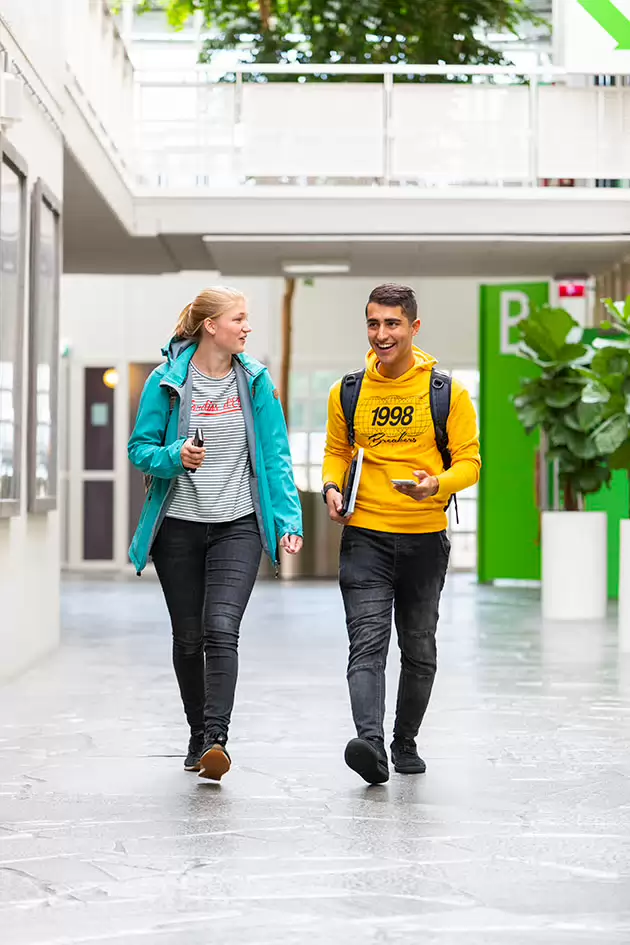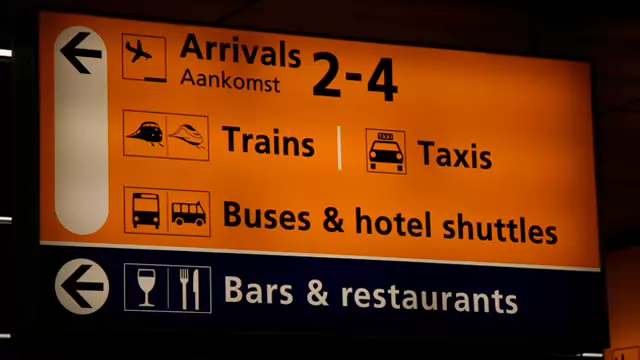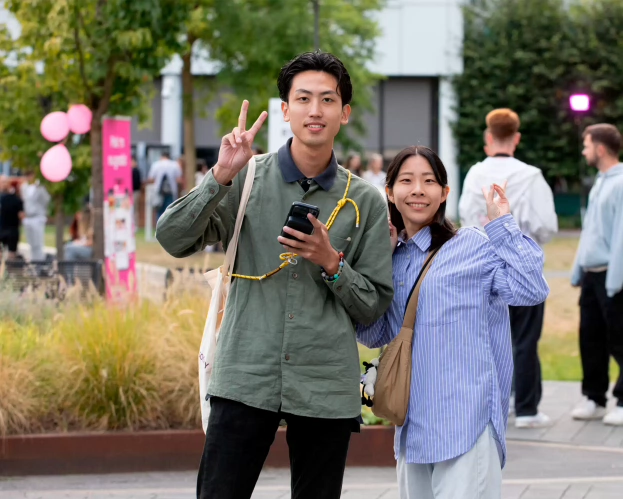
Arrival in the Netherlands
When travelling from far, it is most likely that your point of arrival in the Netherlands will be either at Schiphol Airport in Amsterdam or Eindhoven Airport. When you show your passport to the Immigration Officers, you may be asked why you have come to the Netherlands and if you have enough money to cover both your expenses here and your return ticket.
You will avoid unnecessary delays if you have all of your papers at hand, i.e. your passport (including your Entry Visa/‘MVV’ if applicable) and documentary proof of your official enrolment as a student at Fontys.

-
Arrival at the airport
Arrival at the Central Station in Eindhoven, Tilburg or Venlo
You can travel from the Central Station by bus or by taxi. Please read the information about Public Transportation

-
Public transportation
In the Netherlands public transport consists of trains, buses, trams and metros. Only Amsterdam and Rotterdam have (moderate) underground railway systems.
If you wish to travel by public transport, using an ‘OV-chipkaart’ (public transport chip card) is strongly advised.
Travelling with the 'OV-chipkaart'
The ‘OV-chipkaart’ is a means of payment for the Dutch public transport system. This smart card is the size of a bankcard and contains an invisible chip. The ‘OV-chipkaart’ can be loaded with credit in Euros, with which you can travel anywhere within the Netherlands, or with a travel product (subscription).
When you arrive in the Netherlands and if you are planning to utilise the public transport system, you will need to visit a public transport Service Desk, a vending machine at a railway station, or a tobacco or convenience store to purchase your ‘OV-chipkaart’.
There are two types of ‘OV-chipkaart’ available, as follows:- The anonymous ‘OV-chipkaart’ (blue card),
- The personalised ‘OV-chipkaart’ (yellow card).
If you are planning to utilise public transport frequently during your stay in the Netherlands, it is advised to purchase your own ‘OV-chipkaart’.
Request a student travel product How to buy Dutch train ticketsTrains
The Netherlands has an extensive railway network. Intercity trains run regularly between all Dutch cities. Local trains also stop at intermediate stations. On most trains, you can choose to travel by first or second class. Reservations for seats cannot be made on standard train services. If you do not like to use an 'OV-chipkaart', you may purchase one-use tickets from ticket vending machines at railway stations or online. However, check whether any special offers may apply.
Railway stations are generally located centrally. For further and detailed information regarding departure times and fares, please visit the Nederlandse Spoorwegen (Dutch Railways) website, or contact the Public Transport Travellers’ Information Line via the telephone number, +31900 9292 (EUR 0.70 per minute), which can only be called from within the Netherlands. Or visit the 9292 website.Buses
Outlying villages in the Netherlands are all linked by bus services. All larger towns and cities also have their own extensive bus and/or tram networks and provide regular services. Bus and tram services do not offer separate classes of travel. Buses depart from bus stops and close to the central railway stations.
Visit the 9292 website for information on departure times and fares. -
Bicycle
The Netherlands is perfect for cycling, as more than 100,000 kilometres of trails and road networks are available (including many cycle paths). The Netherlands has a nationwide network of cycle paths totalling approximately 30,000 kilometres in length.
Wherever using cycle paths is mandatory, this is indicated by a blue sign with a white bicycle symbol. Furthermore, cycle paths can be recognised by a red surface on which a white bicycle is printed. In any isolated locations without marked cycle paths, you may rest assured that drivers are generally very aware of cyclists.Cycling to get around
One of the most common ways of moving around in the Netherlands is by bicycle. The Netherlands has more bicycles than people. Many people ride a bicycle and then take a train to travel to work or university, as you will see from the large numbers of bicycles parked at smaller railway stations. Larger railway stations have special bicycle parking garages. In the city centre, you will find places where you can park your bicycle. In some cases, such bicycle parking areas are guarded and in some locations, you will be obliged to pay a fee for parking your bicycle. In the centre, all of the guarded parking areas for bicycles are free of charge. It is important to ensure that you park your bicycle in an appropriate location, or you may return from a nice evening out and discover that your bicycle has been removed by the municipal services.
Fun!
The mild climate, short distances and excellent cycling infrastructure make cycling in the Netherlands not only practical, but also fun! Cycling is a good way to discover the Netherlands. You can hire a bicycle and if you are travelling by rail, you can take your bicycle with you. Just do not forget to purchase a special ticket for your bicycle for the train journey. When you go to another city for a day, you can also opt for renting a NS OV-fiets on a train station.
In the southern part of the Netherlands, there is a multitude of challenging routes through hilly terrain, whereas in the western part of the Netherlands, you can cycle through the dunes. If you like mountain biking, there are also plenty of mountain biking routes in the Netherlands.
Getting a bicycle
Buying a new bicycle will cost between EUR 150 and EUR 500, whereas second-hand bicycles are readily available at much lower prices (e.g. as from approximately EUR 60). It is worth asking someone at the university to suggest a shop, to make enquiries at the ‘fietsenstalling’ (bicycle parking area) at the railway station and/or to regularly check the Notice Board at your university. For second-hand bicycles you can also check Facebook Marketplace or Marktplaats. You should be able to purchase a bicycle for a fair price. It is also important to purchase a good lock and/or chain for your bicycle. Some people secure their bicycles to immovable objects with steel chains to prevent theft. Please note that riding a bicycle without operational lights at night is illegal in the Netherlands, so make sure your bicycle has operational lights.
Instead of buying a bicycle, you can also opt for a subscription with Swapfiets, which includes repairs for a set rate a month.
-
Transportation by car
You will probably discover that it is not necessary to have a car to get around in the Netherlands, as the public transport network extends to all of its remote corners. However, if you do wish to drive in the Netherlands, please check that your driving licence will be valid in the Netherlands and you must ensure that you have adequate insurance cover! It is also important to ensure that you are well acquainted with the national road rules, the required documents and the regulations associated with owning a car in the Netherlands.
Car costs
In the Netherlands, second-hand cars are advertised via the Internet and in newspapers. All cars must display stickers of roadworthiness, which must be renewed on an annual basis, so if you purchase an older vehicle, you must bear in mind that you may be confronted with some unforeseen costs. Although you may find a cheap car, it may cost you a small fortune to get it into the right shape to pass the annual inspection.
In addition, without a sticker of roadworthiness, your insurance will not cover you in the case of an accident and if it is noted by the police that you do not have a sticker of roadworthiness, your car may be confiscated. Other costs that you will need to take into account in running a car will include road tax, mandatory liability insurance, expensive fuel and parking fees in city centres.Road rules
Foreign drivers often find the most unexpected road rule in the Netherlands to be that all traffic coming from the right has the right of way. This is also the case for cars turning out of small side streets, unless signs indicate otherwise. Even cyclists have right of way if they are coming from the right, but pedestrians do not. Cars must stop for pedestrians at zebra (pedestrian) crossings and/or if turning right, but in all cases, pedestrians must exercise extreme care. If you are cycling in the Netherlands, you must always remain vigilant, as drivers sometimes make strange and/or unexpected turns at crossings. In general, Dutch drivers do not tend to drive in a relaxed fashion.

